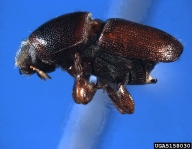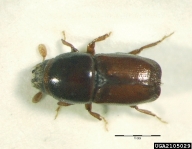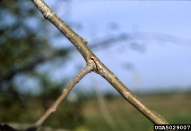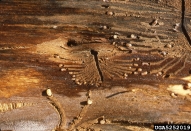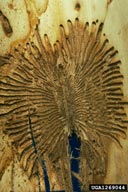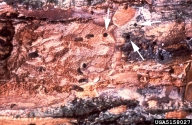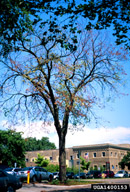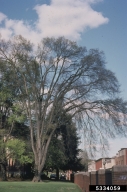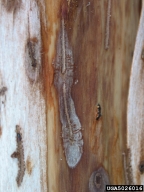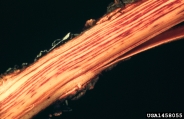Smaller European elm bark beetle
Scolytus multistriatus (Marsham) (Coleoptera: Curculionidae, Scolytinae)
Orientation to pest
Smaller European elm bark beetle, Scolytus multistriatus (Marsham), is an introduced bark beetle that is one of the two main vectors of Dutch elm disease (along with the native elm bark beetle, Hylurgopinus rufipes [Eichhoff]) in the eastern United States and Canada. It was brought to North America through the importation of unbarked elm logs containing live brood of the pest. It breeds in various species of elm, but the greatest damage is done to American elm (Ulmus americana L.). It is widely distributed in the United States. The biology of this species is much the same as for the native elm bark beetle. Adults fly to healthy elm trees in the spring, where they feed on twigs, infecting them with the fungal pathogen (Ophiostoma ulmi [Buisman] Melin and Nannf.) that causes Dutch elm disease. Trees that are stressed by this disease or other factors are attacked by females for breeding. Eggs are laid in galleries that females dig under the bark of the tree. Larvae develop in galleries, feeding in the cambium. Mature larvae overwinter in their galleries, pupating in spring and producing a new flight of adults. Emergence holes have a characteristic "shot hole" appearance. Mass attack on stressed trees is mediated, as in many bark beetles, via an aggregation pheromone. This beetle has displaced the native elm bark beetle in many parts of North America, except in the coldest areas.
Hosts commonly attacked
Smaller European bark beetle attacks all species of Elm (Ulmus) and the Japanese species Zelkova serrata (Thunb.) Makino.
Distribution
This invasive bark beetle is found in a southern Canada and most of the United States except some parts of Florida and Maine.
Images of smaller European elm bark beetle
| Figure 1. Adult of smaller European elm bark beetle, Scolytus multistriatus | Figure 2. Elm branch with feeding in crotch from adults of smaller European elm bark beetle |
| Figure 3. Galleries and brood of smaller European elm bark beetle; central galleries between "wings" are oviposition galleries and the two "wings" are groups of larval galleries; larvae are visible at ends of many galleries in photo on left. | Figure 4. Round emergence holes of the smaller European elm bark beetle |
| Figure 5. Two views of American elms dying of Dutch elm disease | Figure 6. Two views of the streaking and discoloration of the vascular tissue in elms infected with Dutch elm disease |
Important biological control agents related to this pest species
In Europe, several parasitoids are known to attack S. multistriatus. Three of these - Dendrosoter protuberans (Nees), Ecphylus silesicacus (Ratzburg), and Coeloides scolyticida Wesm. - have been introduced into the United States. However, densities of this invasive bark beetle have not been compared between Europe and North America, to see if they were higher in North America than Europe at the time of these introductions. Nor have studies determined if these introductions (some of which did result in establishment) reduced the abundance of this bark beetle. Until recently whether or not this biological control effort had any effect on the target insect was a moot point, as sufficient elm bark beetles remained to allow the Dutch elm disease epidemic to go unchecked, destroying most native elms. The picture is further complicated by the fact that the pathogen, believed to be of Asian origin, has recently evolved to form a new, more aggressive form, Ophiostoma novo-ulmi Brasier. This new pathogen has spread from the American midwestern states into other regions of North America, replacing the form of the pathogen introduced in North America in the 1940s. Nevertheless, the dynamics of this system in the context of replanting disease -resistant American elms in wildlands should now be revisited.
Web links for information on smaller European elm bark beetle
- Digital Diagnostics Fact Sheet | Oklahoma State University
- Bug of the Month Supplement | Pacific Northwest Native Wildlife Gardening
Scarabogram article by Gerry Conley: "European Elm Bark Beetle and Dutch Elm Disease in Seattle" - O & T Guide | New Mexico State University Cooperative Extension
Articles
- Schroder, D. 1974. Investigations on the prospects for biological control of scolytids on elms as a means of reducing Dutch elm disease. Zeitschrift für Angewandte Entomologie 76(2): 150-159. (in German)
